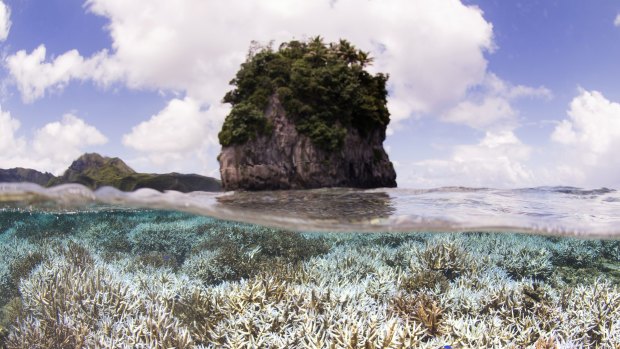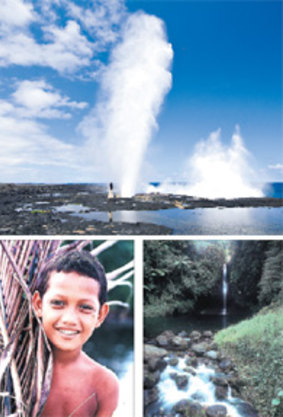
HOLD FOR RELEASE UNTIL 12:01 A.M., TURSDAY, OCT. 8, 2015 - This photo provided by the XL Catlin Seaview Survey, taken in February 2015, shows coral after bleaching in American Samoa, when the XL Catlin Seaview Survey responded to a NOAA coral bleaching alert. Devastating bleaching of colorful coral is spreading into a rare worldwide crisis, scientists announced, predicting it will likely get worse. Triggered by global warming and the El Nino, record hot ocean water is causing the fragile coral to go white and often die, threatening picturesque reefs that are hotspots of marine life, experts say. (XL Catlin Seaview Survey via AP)Credit: AP
Spurred on by manly bravado, the two coconut chuckers have crossed the white line. They inch ever closer to the edge of the precipice and toss in the husks. The swell of the Pacific Ocean clatters against the cliffs, prodding the blowhole into action and the coconuts high into the air.
Pleased with themselves, the guys turn to pose for photos and the Alofaaga blowholes go for a repeat performance. This time, however, the scale has been upped somewhat. The ocean crashes ferociously, turning the whole strip of coastline into an enormous wall of spray. The main blowhole roars as if someone has held a microphone to a plane toilet while it's flushing.

Up the spout ... (clockwise from top) the magnificent Alofaaga blowholes form part of a coastline that becomes a wall of spray; mountains shelter deep bowls of rainforest; a Savai’i boy stops to say hello.
The coconut show-offs are no match and they're sent sprawling along the jagged volcanic rock while the marine equivalent of a fireworks show incites gasps of awe.
Show over, the conquered heroes stagger up, bedraggled and soaked to the bone. They've discovered the hard way that Savai'i's natural wonders have an infinite capacity to surprise.
Savai'i is arguably the South Pacific's greatest secret. The second-most populous of Samoa's islands, it is the biggest landmass in Polynesia outside of New Zealand and Hawaii. It's also a wild, green treasure trove of fascinating natural phenomena the blowholes are merely a starting point.
Along the island's south-east coast are a series of rock arches and sea caves it's like a magnified version of Victoria's Great Ocean Road but with moody black rock.
These hint at the volcanism that has shaped Savai'i. It is thought that there are about 450 volcanic cones on the island arguably the highest concentration on Earth. And sometimes one of those cones gets feisty.
The last eruptions were between 1905 and 1911, when Mount Matavanu discharged lava continuously for six years.
Many villages were ravaged and it's possible to see the results in Saleaula.
Here, among a gigantic field of dried lava, stands a lonely church. It has been completely gutted and inside the black rock has piled up. The lava has flowed gloopily, like honey from a knocked-over jar.
The lava field continues right up to the coastline, making for a spectacular hour-long walk across a dark wilderness, sprinkled with the odd outcrop of pugnacious vegetation.
A little further west along the north road is another relic from the Mount Matavanu eruptions. The Pe'a Pe'a Cave is a lava tube. The hot lava burned its way through the landscape as it poured down the mountainside but what was on top survived. In essence, it burrowed a 500-metre-long tunnel that stretches underneath the road.
A villager acts as a guide to show me the awesome effects and point out signs of life. Moss is growing on the rocks at the entrance, while moths and birds use the cave as a home. Point the torch in the right direction and it's possible to see tiny thimble-size nests belonging to the white-rumped Polynesian swiftlet - or Pe'a Pe'a, as they are known locally.
To see hundreds of the Pe'a Pe'a in flight, however, it's best to detour off the usual island circle route.
The Tafua Peninsula is a truly gorgeous place that can be missed by even the most intrepid visitors to Savai'i.
The peninsula contains a rainforest reserve and a crater that can be accessed via a relatively rough 45-minute hike around the rim.
From the top, the views are staggering. You look across at the mountains of Savai'i's interior and down into a deep bowl full of trees so green the saturation must have been turned up to 11. It's very Jurassic Park or Lost.
Flying around those trees are the Pe'a Pe'a. And if you're patient enough, the teenie-weenie birds are accompanied by flying foxes gliding along the thermals.
They're magnificent animals and it's an utter privilege to watch them. Sitting on the edge of the crater, cross-legged and dewy-eyed, is a way to let minutes turn into hours.
Savai'i has the ability to induce those heart-in-mouth, this-is-something-special kind of moments. This applies right to the very end of the island.
Cape Mulinu'u is Savai'i's far western tip and it is widely believed to be the last place in the world to see the sun set each day. The cape combines all the elements that make Savai'i the Pacific's wild paradise. There are a few little fales Samoan beach huts to sleep in. They're backed by thick greenery and sit alongside photogenic coconut palms, which bend towards the sea.
Then comes the bright, sandy beach, with rock pools and a volcanic-rock ledge to clamber upon. From on top, a softly painted X marks the spot where the world's day ends.
And from there, it's just ocean on the horizon, flecked by the imaginary dashes of the International Date Line.
The writer was a guest of the Samoa Tourism Authority.
Sign up for the Traveller Deals newsletter
Get exclusive travel deals delivered straight to your inbox. Sign up now.